Laser Safety

Laser therapy is extremely safe when basic protocols are followed by the laser operator and support staff. As with all therapeutic procedures, some element of risk is present through negligence or accident. These hazards are easily prevented or reduced with safety protocols for each application. Every clinic using a laser should have an individual trained in safe operation of laser therapy and regularly use a safety checklist. This individual (often the doctor), is the Laser Safety Officer (LSO).
Eye Protection
Class 4 Therapy Lasers can emit both visible and invisible radiation. Protective eyewear is necessary for both Class 3 and Class 4 lasers where irradiation of the eye is possible.
Required Users
- Administrator of the laser therapy treatment
- Patient (If treating near the head area of the horse, using a towel of blinkers to block any potential laser exposure is recommended.)
- Any other individuals in the room or treatment area
Safety Goggles

Not all Safety Goggles are the same. The protective eyewear that came with your laser is manufactured specifically for the wavelengths emitted by the laser. Do not use protective eyewear from other manufacturers as they may not provide the appropriate level of protection.
Typical Specifications for proper usage include:
- Wavelength Specific
- Blocks 1064nm
- Meets ANSI Safety Standards
Using Safety Goggles Correctly
Laser safety glasses are vital for eye protection in the presence of laser radiation. Since accidental laser radiation exposure can cause irreversible damage to the human eye, protective measures must not be taken lightly. Ensure that the eyewear has appropriate optical density for the wavelength of operation. Remove all reflective objects (such as rings, metal watchbands, and jewelry) prior to treatment with the laser. Indirect or direct eye contact with the laser beam or with scattered laser light from any reflective surfaces will cause serious damage, irreparable corneal and/or retinal damage, and possible blindness to one or both eyes. Do not allow any reflective object to fall into, or obstruct the path of the laser beam. Always wear protective eyewear. Any person present during the laser operation must wear protective eyewear.
Never look directly into the end of any laser hand piece.
Never direct the laser light directly into the eyes, or direct the laser beam at anything other than the area to be treated with or without the correct Safety Goggles.
Do not remove the Safety Goggles until the administrator of the laser has turned off the laser or notified the patient that it is safe to remove them.
Signage

Lasers require the use of specific Warning Signs for the safe operations of each laser system. Warning signs must be in view outside and inside the room or treatment area where the laser treatment is being performed. Warning signs must meet ANSI recommendations.
Laser Safety Checklist
- Appropriate warning signs posted
- Access to laser and treatment area is secure and controlled
- Visually inspect and clean all optical connectors for dirt, debris, etc.
- Inspect laser for proper function
- Visually inspect and clean all Safety Goggles
- Safety Goggles available for all persons in Nominal Ocular Hazard Zone
- Extra Safety Goggles placed outside treatment room if necessary
- Sources of potential laser beam reflection and scatter controlled
- Treatment protocol established for patient
- Laser injury management protocol in place for accidental injury
- Document laser treatment and post-treatment outcome Contraindications
- Do not apply over an implanted device, i.e. a pacemaker. (pet microchip OK)
- Do not apply over the thyroid gland, ovaries or testicles.
- Do not treat over any cancer/malignancy.
- Do not treat over an actively hemorrhaging area.
Safety
- Familiarity with safety shutoff devices on laser
- Eye protection, specifically supplied goggles
- Patient- goggles and/or eye shields
- Attending therapists within the treatment room
- Others such as pet owners, etc. within the treatment room
- Post the “Laser Safety Warning” sign(s) in appropriate location(s)
- Consideration of therapy in a safe laser environment
Guidelines
Sound Technologies, Inc. user information is in compliance with EN / IEC 60825-1:2014 and FDA Laser Notice No. 56.
Laser Safety Supervision
Designate at least one person at each facility that utilizes this device as Laser Safety Officer, responsible for providing training on all operating safety procedures.
Laser Safety
Precautions
- Never allow untrained personnel to operate this device unless directly supervised by a properly trained and experienced individual.
- The protective eyewear supplied with this device has an optical density rating >5 in the 1064 nm region. All personnel present during device operation must wear this eyewear. Contact Sound Technologies, Inc. at 800-268-5354 Option 1 to purchase additional sets of protective eyewear for this device.
- Select a secure, properly equipped, and well-ventilated location in which to install and operate the laser.
- Place “Laser Safety Warning” signs at location entrances where people will use the SMART RLT Sport laser device.
- Always put the laser in Standby mode or switch the device off prior to adjusting or preparing the hand piece or fiber optic.
- Never leave this device in the READY mode unattended. See the STANDBY to READY Mode in the Operations section of this manual.
- Log off the laser when not in use to prevent unauthorized and/or unqualified use of the device as well as inadvertent laser emissions.
- Turn the device off before relocating equipment in the same vicinity.
- Never press the hand-switch without first verifying the safe orientation and proper positioning of the hand piece and distal end of the optical fiber and ensuring compliance to all safety precautions.
- During any laser procedure, do not allow any nonessential personnel into the treatment area.
Warnings
- This laser device is sold solely for VETERINARY purposes only! More specifically for equine species! Under NO circumstances should this laser system be used as a medical device for Human use or companion and other animals!
- This laser device produces 1064 nanometer near infrared laser energy that is invisible and can be an extreme hazard to the eyes of any living being. Irreparable corneal and/or retinal damage may occur if a person exposes one or both eyes to direct or indirect (reflected) laser energy.
- IMPROPER USE OF SYSTEM CONTROLS or performance of procedures other than those specified in this manual may result in hazardous radiation exposure.
- FAILURE TO COMPLY with all safety instructions and warnings may expose all participants to harmful levels of laser radiation and/or dangerous levels of electrical current.
- NEVER direct the laser beam at anything other than the area to be treated.
- NEVER allow the eyes of any living being to look directly into the distal end of the optical fiber connected to an active laser device - WITH or WITHOUT wearing appropriate laser-emission protective eyewear.
- DO NOT allow any reflective object to fall into or obstruct the path of the laser energy produced by this device. Scattered or reflected laser energy can cause serious damage to eyes and skin. The operator, all assistants, and the patient must remove all reflective objects (such as rings, metal watchbands, and jewelry) prior to treatment with this device.
- NEVER open or operate the system if damaged or not operating properly.
- THERE ARE NO USER-SERVICEABLE COMPONENTS inside this laser device. Therefore, do not attempt to gain access to any internal device component. Doing so may cause serious and/or irreversible injury and void the warranty. For service, contact Sound Technologies, Inc. at 800-268-5354 Option 3.
- DO NOT remove protective eyewear until the operator returns the laser device to Standby mode. To do this, the operator releases the hand -switch at completion of the treatment or cancels treatment by pressing “Laser Ready” button and waiting until the operator visually observes the laser device returning to Standby.
- AVOID THE USE of flammable anesthetics or oxidizing gases such as nitrous oxide (N2O) and oxygen. The high temperatures produced in normal use of the laser equipment may ignite some material, for example cotton or wool, when saturated with oxygen. The solvents of adhesives and flammable solutions used for cleaning and disinfecting should be allowed to evaporate before the laser equipment is used. Attention should also be drawn to the danger of ignition of endogenous gases.
- If the laser fails to operate properly, contact Sound Technologies, Inc. at 800-268-5354 Option 3.
Labels and Symbols
The following labels appear on the SMART RLT Sport laser.
Manufacture (Factory) Identification Label
The label indicates the manufacturer, model number, serial number (S/N i.e.: 191006-004) and date of manufacture (DOM = Month/Year i.e.: October 2019) of the SMART RLT Sport.
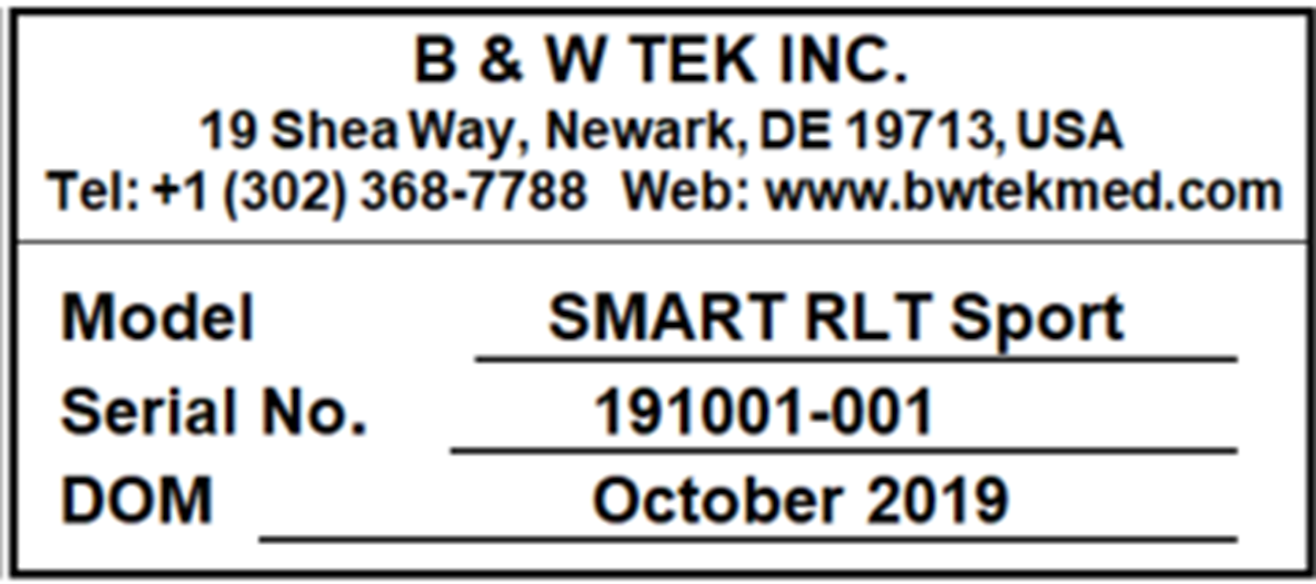
Explanatory and classification label
Located on the lower side of the deck. These labels indicate the laser classification and laser safety warning.


Aperture Label and Aperture Icon
Located on the hand piece. This label indicates the laser aperture. The laser emission can only be emitted from the laser aperture on the hand piece.

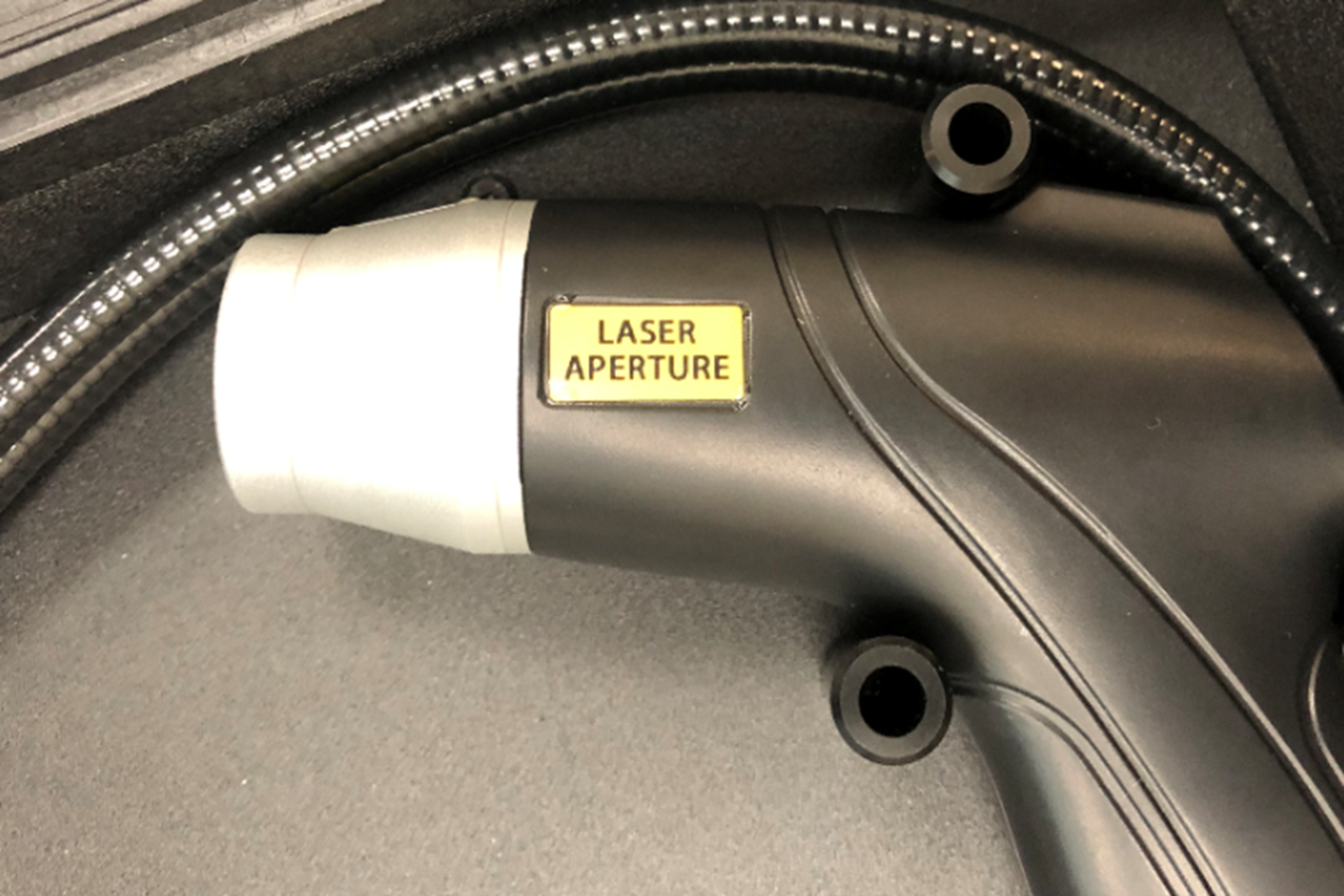
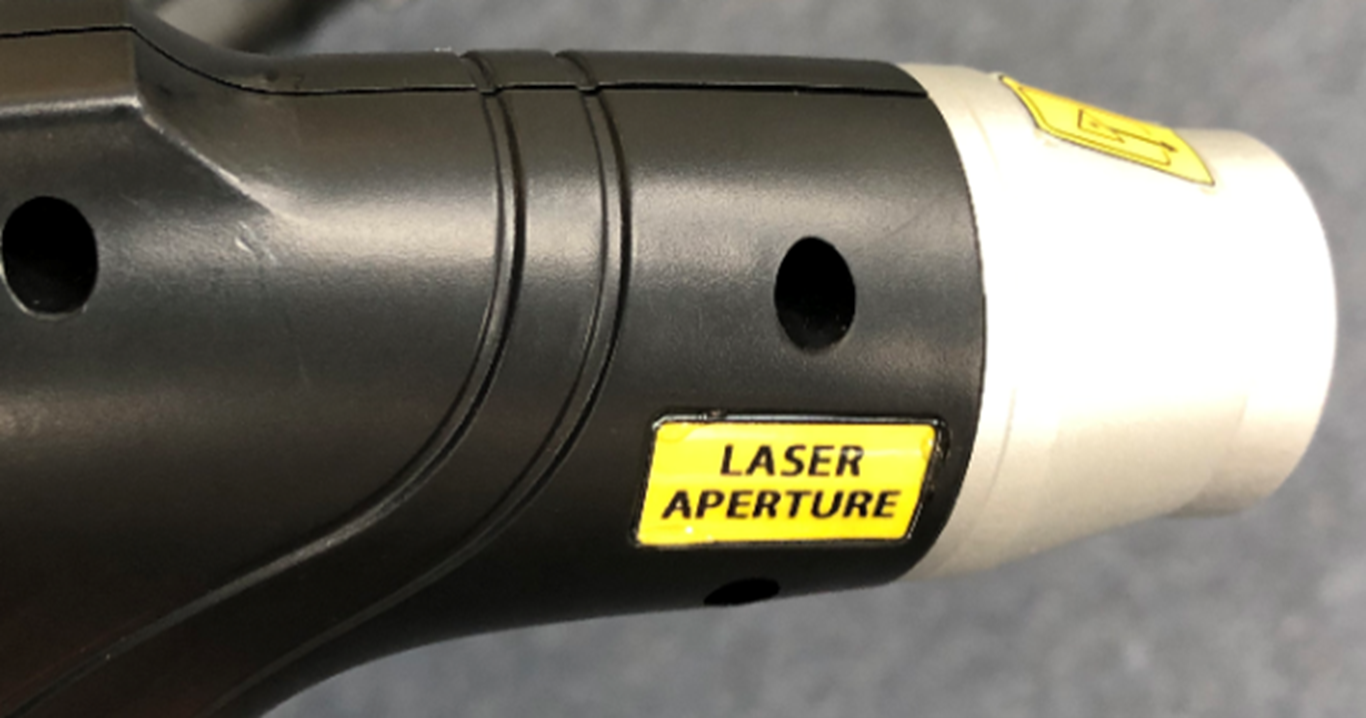
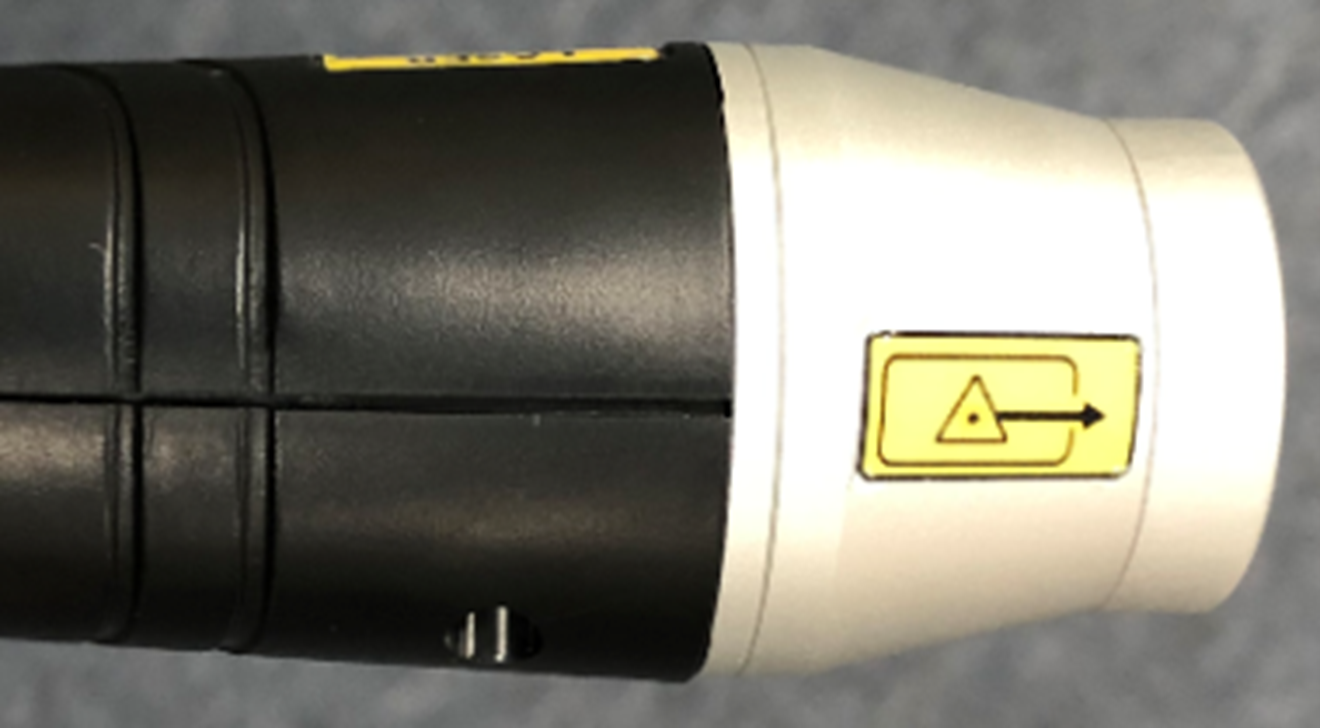
International Laser Hazard Symbol
This icon denotes a laser product located on the lower side of the deck
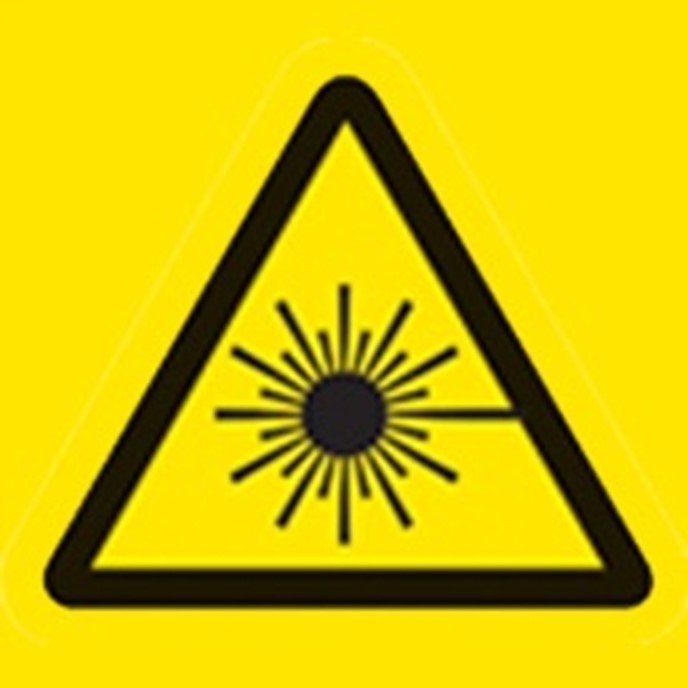
Non-interlock protective housing label
Located on the deck close to the fiber cable port. The label indicates the laser safety warning when the panel is open.

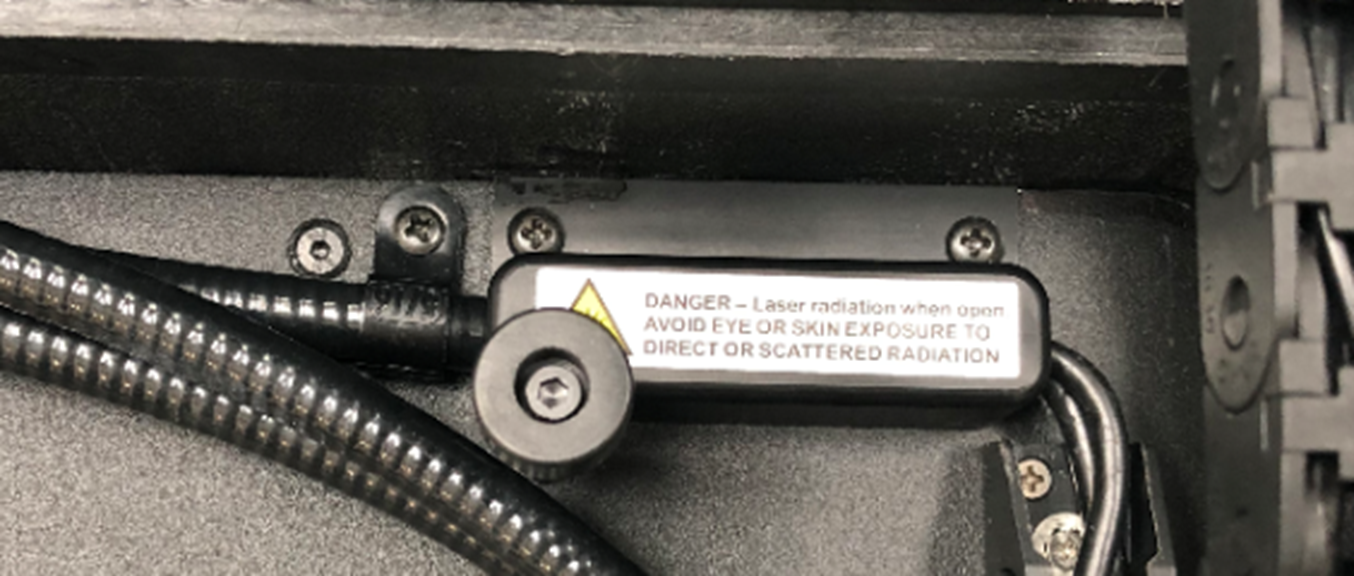
Warranty Seal Label
Located on the lower side of the deck. Any attempt to open the top plate of this device will break this seal voiding the system warranty
Certification Label
Located on the lower side of the deck this label denotes Compliance with CDRH requirements.

Sound Label
Located on the outside of the system adjacent to the power entry module this label indicates electrical power requirements and additional regulatory information.
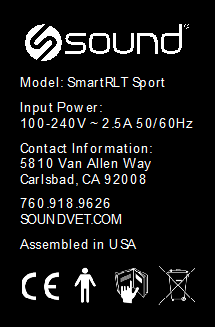
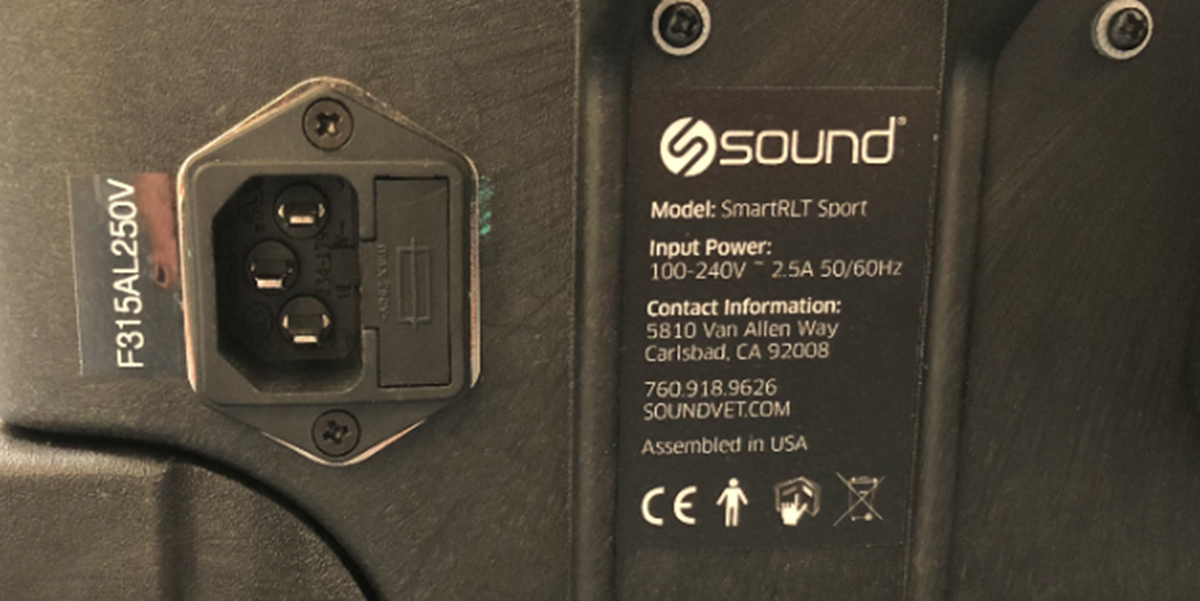
Safety Devices
The following component devices have specific safety-related features. All individuals who use this laser device should be familiar with the purpose and the operation of these components.
Emergency Power off Switch
This switch is located on the deck of the SMART RLT Sport. Pushing the switch down terminates all electrical power to the laser device’s microprocessor and laser-emitting components. Resetting the switch restores power. To reset the Emergency Power Off Switch, the user must press, twist, and rotate in the direction indicated by the arrows, then release it as the switch pops out, returning it to its normal position. SMART RLT Sport software must be stopped and restarted.

Power On/Off Visual Indicator
Located on the top plate of the laser device, the green LED indicator is illuminated continuously whenever the system is powered on, the tablet is running and the emergency power off switch is disabled.
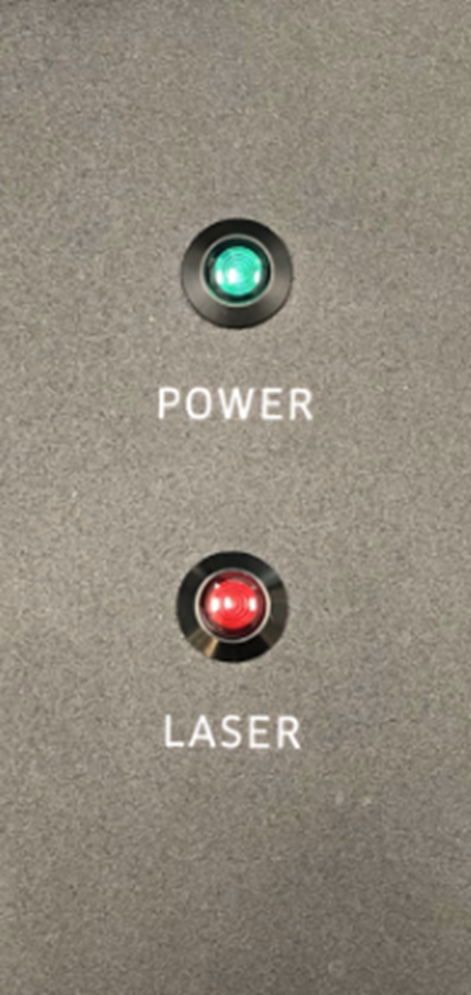
Laser-Emission LED Indicator
The red LED on the top plate of the laser system will be illuminated flashing when the laser emission is ON.
Laser-Emission Audio Indicator
The laser will have an audio beeping sound when the laser is emitting. This audio comes from the tablet speakers so sound should never be muted on turned below an audible range on the tablet.
The operator should never mute or turn off the audio on the tablet. This audio is used as an additional indicator when the laser is in emission mode.
Remote Interlock
The purpose of the remote interlock connector is to permit the user to connect a remote barrier interlock, emergency stop switch, or similar device. The connector must be in place for the unit to function or a remote interlocking system is connected to the unit.
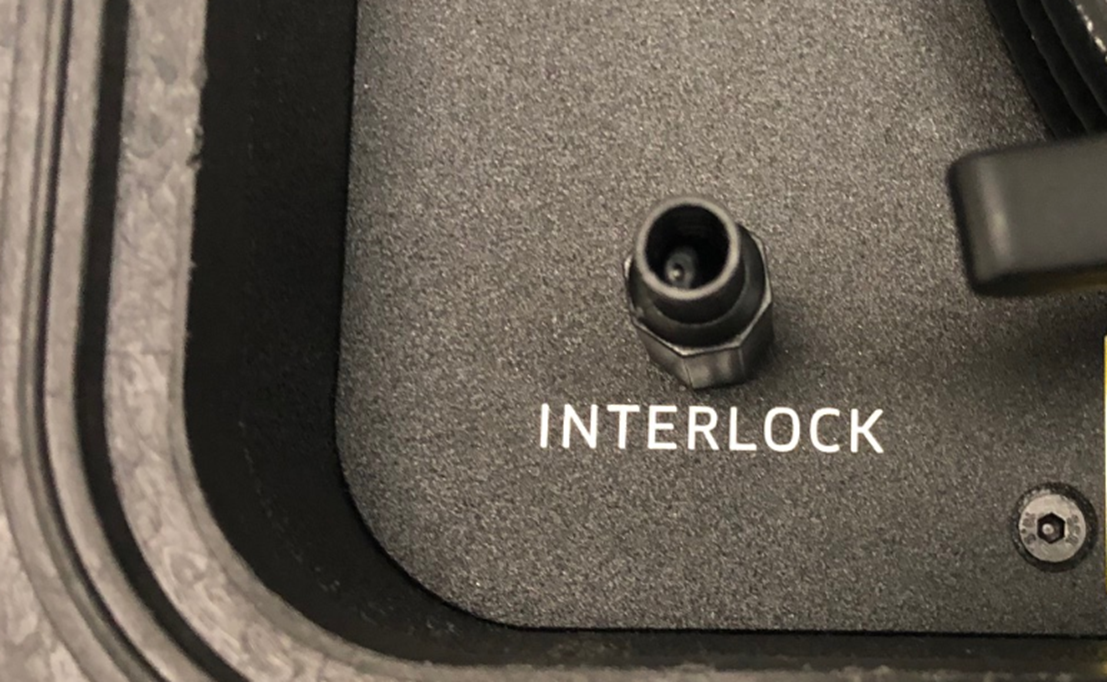
Laser-Emission Hand Piece LED Indicator
There is an LED on the hand piece that will flash when the laser is in emission mode.

On Screen Emission Indicator
The system software on the tablet will have a flashing red indicator that appears as follows on the screen during emission

Watchdog Timer
The laser firmware will automatically halt laser emission if the tablet software does not message the firmware once every half second during laser operation. This is to prevent a loss of communication to the firmware preventing a hazardous situation.
Laser Eye Protection
The protective laser eyewear supplied with this device has an optical density rating > 5.0 for 1064nm laser emission. All personnel present during device operation must wear this eyewear. Contact Sound Technologies, Inc. at 800-268-5354 Option 1 to purchase additional sets of 1064-nm protective eyewear.
Absolute ContraIndication
Directly into the eye
The lens of the eye focus light so a power density that is safe outside the body can be DANGEROUSLY high once focused on the retina. Also, we do not have a blink reflex to infrared light since it is invisible to our eyes, so your natural defense is no help.
You CAN treat along the periphery of the eye. As long as the light is not focused by the lens of the eye (i.e. does not enter the eye’s cone-field of view) the light can be used as a very effective therapy.
Directly over a cancer or tumor
Laser therapy promotes cellular metabolism and proliferation regardless of whether the cell is healthy, damaged, benign, or malignant. The last thing you want is to stimulate an already over-productive cell that is fighting against the body.
For terminal cases, laser therapy can certainly increase a patient’s quality of life. Make sure to educate and get consent from the pet-owner. Also, you CAN treat anatomies that are geographically isolated from a tumor if you are confident there are no metasteses in the area.
Directly over gravid uterus
This is strictly for medical legal reasons.
There has never been any study showing any negative risk of laser therapy to an unborn fetus.
Directly over recent steroid/NSAID injection site
There are a wide variety of chemicals in these injections, some of which are light- or heat-sensitive. Also, the concentration of some injections is very high around injection sites, so to avoid any irritation, best practice is to stay away from these sites.
You CAN treat pre-injection. The actual light is what can potentially irritate the injection site, and after treatment there is no light. You can wait a full biological half-life of the drug to begin treating around an injection site.
Directly over Thyroid gland
This is where many of the body’s hormones are produced. There is a risk to over-produce some of them, which could lead to negative clinical side-effects.
For hypothyroid conditions, laser therapy may actually help. Also, studies have shown an increase in melatonin and other useful endorphins by treating the pituitary gland. Using this positive system effect could be advantageous.